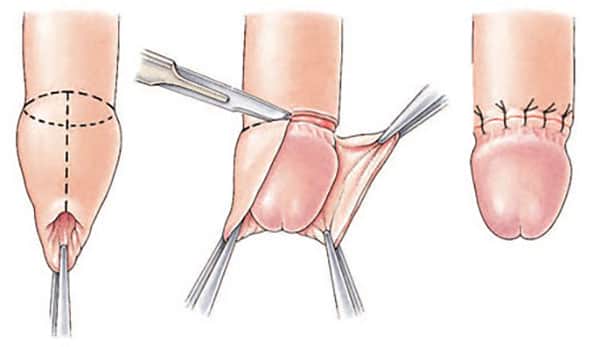What is a circumcision?
A circumcision is an operation to remove the foreskin (the fold of skin which covers the head of the penis).
Why do I need a circumcision?
There are a number of reasons why a circumcision might be recommended:
- Tightening of the foreskin (phimosis) so that it cannot retract fully and reveal the head (glans) of the penis.
- Repeated infections or inflammation of the head of the penis (balanitis).
- Acute, painful swelling of the glans when the foreskin gets stuck behind it.
- Repeated bleeding and / or pain during intercourse.
- Suspicion of a growth on the penis.
What should I expect before the procedure?
You will usually be admitted on the same day as your surgery.
You will be asked not to eat and drink for six hours before surgery. Immediately before the operation, the anaesthetist may give you a pre-medication, which will make you dry-mouthed and pleasantly sleepy.
Please tell your surgeon (before your surgery) if you have any of the following:
- An artificial heart valve.
- A coronary artery stent.
- A heart pacemaker or defibrillator.
- An artificial joint.
- An artificial blood-vessel graft.
- A neurosurgical shunt.
- Any other implanted foreign body.
- A regular prescription for warfarin, aspirin or clopidogrel (Plavix®).
How is it performed?

The operation is usually performed under a general anaesthetic but occasionally may be done under a local anaesthetic. It is usually done as a day-case procedure, which means that you will be allowed home 3-4 hours after you have recovered from your general anaesthetic.
The fold of skin which slides over the head of the penis (glans) is removed and the skin edges are closed together with dissolving stitches.
What are the risks, consequences and alternatives associated with having a circumcision?
Most procedures are straightforward; however as with any surgical procedure there is a chance of side effects or complications.
Occasional
- Bleeding from the wound occasionally needing a further procedure.
- Wound infection that requires antibiotics.
- Permanent altered or reduced sensation of penis.
- Persistence of absorbable stitches after 3-4 weeks requiring removal.
Rare
- Scar tenderness, rarely long term.
- Being unhappy about the appearance of the penis.
- Need for removal of excess skin at later date.
- A biopsy of abnormal area on glans if cancer a concern.
Alternatives to circumcision
- Anti-inflammatory or antibiotic creams.
- Frenuloplasty (operation to loosen the frenulum).
- Prepucioplasty or Dorsal Split (operation to try to loosen the foreskin).
Post-operative care and discharge
After the effects of your general anaesthetic pass, you may eat and drink. There will be some dissolvable stitches and a dressing. You will be able to pass urine with this on, and we advise you to keep the dressing on overnight.
For the next 7 days, you may shower and lightly wash the area of the wound with water. There is no need to use any creams or lotions and a dressing is not usually required after 24 hours.
The penis will often look swollen and red, which is quite normal and settles with time. Some scabs may also form over the wound site – again this is quite normal and these will flake off with time. When the stitches start to dissolve, the wound can look gluey. Do not worry about this, once the stitched have fallen out the cosmetic appearance of the penis will be much better.
You should avoid sexual intercourse and masturbation for 4-6 weeks.
You should generally be able to return to normal activity after 2-3 days.
Disclaimer
This information is intended as a general educational guide and may not apply to your situation. You must not rely on this information as an alternative to consultation with your urologist or other health professional.
Not all potential complications are listed, and you must talk to your urologist about the complications specific to your situation.
